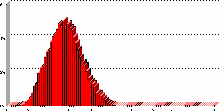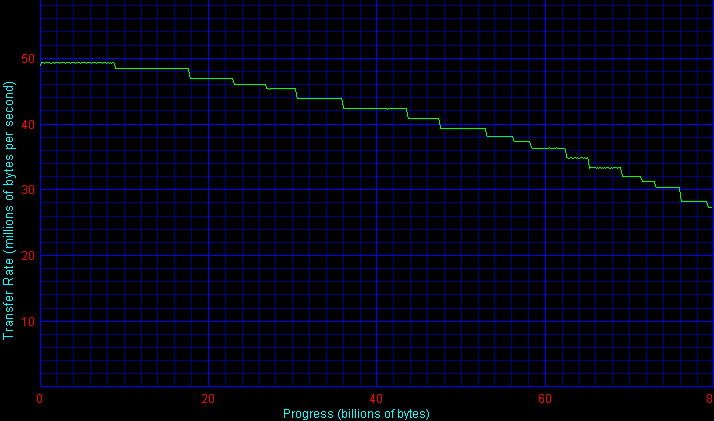|

Last month, however, the manufacturer announced the Caviar WD800JB, an 80 GB drive featuring an 8-megabyte buffer. The initial announcement implied that, just like the WD800BB, the new drive featured 27 GB platters. This made sense in a way- perhaps Western Digital needed to clear out its inventory of lower-capacity platters and wanted to sweeten its offering by bumping up the buffer. Interestingly, however, all references have changed since then. Specs now indicate a two platter design utilizing contemporary 40-gig platters. This leads us to the company’s irritating naming practice. Unlike those of other manufacturers (where one knows that a 120GXP, a D740X, a ‘Cuda ATA IV, etc. feature 40-gig platters), WD’s drive names don’t really indicate the drive’s platter capacity. Thus, it’s difficult to ensure one’s receiving a state-of-the-art unit when purchasing anything but the largest WD drives. On one hand, this is good business sense: most purchasers aren’t aware that differing platter capacities can impact performance. On the other, it makes it difficult for savvy groups (say… SR readers) to obtain the product they seek.

With the WD800JB, Western Digital targets users who seek the JB series’ high-end performance without its high-end capacity. Enthusiasts seeking to wring the last bit of performance out of their rigs predominately compose the target market. A three-year warranty backs the product.
Let’s see if the WD800JB lives up to its heritage!
Low-Level ResultsFor diagnostic purposes only, StorageReview measures the following low-level parameters: Average Read Access Time– An average of 25,000 random accesses of a single sector each conducted through IPEAK SPT’s AnalyzeDisk suite. The high sample size permits a much more accurate reading than most typical benchmarks deliver and provides an excellent figure with which one may contrast the claimed access time (claimed seek time + the drive spindle speed’s average rotational latency) provided by manufacturers. WB99 Disk/Read Transfer Rate – Begin– The sequential transfer rate attained by the outermost zones in the hard disk. The figure typically represents the highest sustained transfer rate a drive delivers. WB99 Disk/Read Transfer Rate – End– The sequential transfer rate attained by the innermost zones in the hard disk. The figure typically represents the lowest sustained transfer rate a drive delivers. |
For more information, please click here.
|
Note: Scores on top are better. |
|
|||||||||||||||||||||||||||||||||||||||||||||
|
|
||||||||||||||||||||||||||||||||||||||||||||
WD800JB Average Read Service Time |
WD800JB Average Write Service Time
|
||||||||||||||||||||||||||||||||||||||||||||
The WD800JB turns in an average read access time of 13.9 milliseconds. Subtracting 4.2 ms to account for the average rotational latency of a 7200 RPM drive yields a measured average seek time of 9.7 ms, quite a bit off of the company’s 8.9 ms claim. Such figures are on the slow side for today’s 7200 RPM drives; only Seagate’s Barracuda ATA IV turns in a similar score.
|
Note: Scores on top are better. |
|
|||||||||||||||||||||||||||||||||||||||||||||
|
|
||||||||||||||||||||||||||||||||||||||||||||
WD800JB Transfer Rate
|
|||||||||||||||||||||||||||||||||||||||||||||
Transfer rates, on the other hand, are spectacular. The Caviar’s outer-zone result of 49.3 MB/sec is the highest we’ve yet recorded for an ATA drive, besting (albeit at a negligible margin) Western Digital’s own WD1200JB. Inner-zone scores too weigh in impressively at 29.2 MB/sec.
Single-User PerformanceStorageReview uses the following tests to assess non-server use: StorageReview.com Office DriveMark 2002– A capture of 30 minutes of actual computer productivity use that exactingly recreates a typical office-style multitasking environment. The applications include: Outlook XP, Word XP, Excel XP, PowerPoint XP, Calypso (a freeware e-mail client), SecureCRT v3.3 (a telnet/SSH client), CuteFTP Pro v1.0 (an FTP/SSH client), ICQ 2000b), Palm Hotsync 4.0, Gravity 2.3 (a Usenet/newsgroups client), PaintShop Pro v7.0, Media Player v8 for the occasional MP3, and Internet Explorer 6.0. StorageReview.com High-End DriveMark 2002– A capture of VeriTest’s Content Creation Winstone 2001 suite. Applications include Adobe Photoshop v5.5, Adobe Premiere v5.1, Macromedia Director v8.0, Macromedia Dreamweaver v3.0, Netscape Navigator v4.73, and Sonic Foundry Sound Forge v4.5. Unlike typical productivity applications, high-end audio- and video- editing programs are run in a more serial and less multitasked manner. The High-End DriveMark includes significantly more sequential transfers and write (as opposed to read) operations. |
StorageReview.com Bootup DriveMark 2002– A capture of the rather unusual Windows XP bootup process. Windows XP’s boot procedure involves significantly different access patterns and queue depths than those found in other disk accesses. This test recreates Windows XP’s bootup from the initial bootstrap load all the way to initialization and loading of the following memory-resident utilities: Dimension4 (a time synchronizer), Norton Antivirus 2002 AutoProtect, Palm Hotsync v4.0, and ICQ 2000b.
StorageReview.com Gaming DriveMark 2002– A weighted average of the disk accesses featured in five popular PC games: Lionhead’s Black & White v1.1, Valve’s Half-Life: Counterstrike v1.3, Blizzard’s Diablo 2: Lord of Destruction v1.09b, Maxis’s The Sims: House Party v1.0, and Epic’s Unreal Tournament v4.36. Games, of course, are not multitasked- all five titles were run in a serial fashion featuring approximately half an hour of play time per game.
For more information, please click here.
|
Note: Scores on top are better. |
It’s in higher-level, real-world tests that the WD800JB truly gets to stretch its legs. The drive scores 395 I/Os per second in the StorageReview.com Office DriveMark 2002, a result that places it up there with the WD1000BB-SE (WD1000JB) and WD1200JB. For typical office use, the WD800JB is 30+% faster than drives such as the Barracuda ATA IV or DiamondMax D740X.
Such margins hold up in the High-End, Bootup, and Gaming patterns. The WD800JB’s larger buffer and accompanying firmware easily erase any disadvantages that may arise from the drive’s higher seek times and lower capacity.
Multi-User PerformanceStorageReview uses the following tests to assess server performance: StorageReview.com File Server DriveMark 2002– A mix of synthetically-created reads and writes through IOMeter that attempts to model the heavily random access that a dedicated file server experiences. Individual tests are run under loads with 1 I/O, 4 I/Os, 16 I/Os, and 64 I/Os outstanding. The Server DriveMark is a convenient at-a-glance figure derived from the weighted average of results obtained from the four different loads. StorageReview.com Web Server DriveMark 2002– A mix of synthetically-created reads through IOMeter that attempts to model the heavily random access that a dedicated web server experiences. Individual tests are run under loads with 1 I/O, 4 I/Os, 16 I/Os, and 64 I/Os outstanding. The Server DriveMark is a convenient at-a-glance figure derived from the weighted average of results obtained from the four different loads. For more information click here. |
|
Note: Scores on top are better. |
|
|||||||||||||||||||||||||||||||||||||||||||||
|
|
||||||||||||||||||||||||||||||||||||||||||||
The WD800JB turns in very typical ATA performance in out server suites; in other words, just as most of its competitors, WD’s drive lags behind even the slowest SCSI drives when it comes to multi-user environments.
Legacy PerformanceeTesting Lab’s WinBench 99 Disk WinMark tests are benchmarks that attempt to measure desktop performance through a rather dated recording of high-level applications. Despite their age, the Disk WinMarks are somewhat of an industry standard. The following results serve only as a reference; SR does not factor them into final judgments and recommends that readers do the same. |
|
Note: Scores on top are better. |
|
|||||||||||||||||||||||||||||||||||||||||||||
|
|
||||||||||||||||||||||||||||||||||||||||||||
Heat and NoiseIdle Noise– The sound pressure emitted from a drive measured at a distance of 18 millimeters. The close-field measurement allows for increased resolution between drive sound pressures and eliminates interactions from outside environmental noise. Note that while the measurement is an A-weighted decibel score that weighs frequencies in proportion to human ear sensitivity, a low score does not necessarily predict whether or not a drive will exhibit a high-pitch whine that some may find intrusive. Conversely, a high score does not necessarily indicate that the drive exhibits an intrusive noise envelope. Net Drive Temperature– The highest temperature recorded from a 16-point sample of a drive’s top plate after it has been under heavy load for 80 minutes. The figures provided are net temperatures representing the difference between the measured drive temperature and ambient temperature. For more information, please click here. |
|
Note: Scores on top are better. |
|
|||||||||||||||||||||||||||||||||||||||||||||
|
|
||||||||||||||||||||||||||||||||||||||||||||
A two-platter design, the WD800JB turns in a relatively low noise floor, shaving more than 2 dB/A off of the scores delivered by Western Digital’s three-disk designs. The Caviar’s objective idle-noise score is in line with the competition- only Seagate’s Barracuda ATA IV delivers significantly lower acoustics. Subjectively speaking, the drive’s seek noises are among the quietest we’ve heard, something unsurprising given the drive’s rather high average access times.
At just 15.3 degrees Celsius above ambient room temperature, WD’s drive is among the coolest we’ve yet measured. It should be easy to integrate into virtually any kind of setup.
ConclusionSince the introduction of the WD400BB more than 1.5 years ago, every Caviar drive has received our Safe Buy award by delivering best-of-class performance- a remarkable streak indeed! The Caviar WD800JB is no exception. Basically a WD1200JB with one less platter, the 800JB delivers similar performance with less capacity, heat, noise, and cost. A quick glance at pricing indicates a $20 premium over other 80 GB drives. Unless one is on an extremely tight budget, the low cost, noise and heat levels of the WD800JB make it an easy choice. |




 Amazon
Amazon